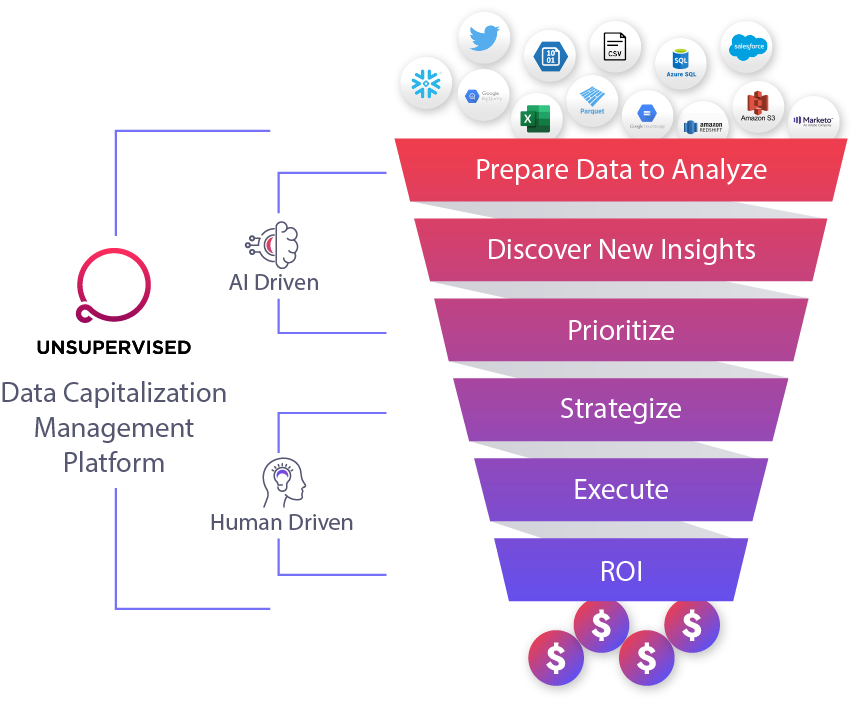What is Data Capitalization Management?
Let’s start with a definition:
Data Capitalization Management, or DCM, is the practice of transforming an organization’s data into monetary value. This is accomplished by identifying, prioritizing and tracking insights based on the ROI impact for the business.
The words used here are important. If BI is about providing a system for managing the business, and analytics is about probing into ad hoc questions about the business, DCM is about automating the discovery of insights based on the key performance indicators (KPIs) business teams are trying to improve and providing a workflow for tracking the monetary value of acting on those insights.
If this sounds vaguely academic, let’s think of it in terms of the process for how insights are funneled through an organization.
The Data Capitalization Funnel
There are six basic stages for how data analysis works within an organization:
Preparation: Data needs to be prepared which can include structuring, cleaning and joining of different types of data. Too often lots of data is left out of the analysis due to the limitations of human cognition and traditional AI platforms.
Insight Discovery: Data is analyzed and insights are found in a treasure hunt type involving long cycle times.
Prioritization: Insights are prioritized by data and business teams, usually based on a high-level understanding of the potential impact for that team and their KPIs.
Strategy: Actions to take based on the insights, over what period of time, and the team members required will be determined at this stage.
Execution: The strategy is enacted by select team members which can often involve AI-driven models to automate decision-making.
ROI: The results of the plan are reported up to the team and data leads, often in spreadsheets and PowerPoint presentations. In many cases, the ROI is nebulous with outcomes not expressed in monetary capture.

Like all funnels, we start with a lot at the top and the output is constrained through each stage. The main constraint, though, is where we apply human and artificial intelligence. At a majority of organizations, human energy is spent at the top of this funnel, leaving teams to do the heavy lifting of preparing and sifting through an overwhelming amount of data in search of insights. AI is applied at the bottom of this funnel where human decision-making is most critical.
There are all kinds of inefficiencies in this model including lengthy cycles to get to insights, lack of specificity in the insights due to potentially valuable data left out of the analysis, etc.
But most importantly, the people within the business — from how products are marketed and sold to supply chain and risk management — have surprisingly little access to the data-backed insights as they continue to make the most crucial decisions for the business despite the increasing growth of automation.
The DCM version of the funnel flips the roles of AI and human intelligence. AI is applied to the vast and complex work of preparing and enhancing data, and finding meaningful patterns within that complex data. Human time and talent is focused on strategizing and executing on those insights, resulting in increased money into the company in the form of top line or bottomline revenue.
After “Human time and talent is focused on strategizing and executing on those insights, resulting in increased money into the company in the form of top line or bottomline revenue.”
That’s why our customers have identified more than $65 million in opportunities in 2021 alone.








